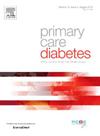The effect of COVID-19 pandemic on new-onset adult diabetes and its one-year follow-up
IF 2.6
4区 医学
Q3 ENDOCRINOLOGY & METABOLISM
引用次数: 0
Abstract
Aims
Bidirectional detrimental relationships between COVID-19 infection and diabetes have been described globally. However, new-onset diabetes in adults and its follow-up during the pandemic have not been sufficiently investigated. In this study, new-onset autoimmune and type 2 diabetes cases during the pandemic were compared to those before the pandemic, and the clinical course of new-onset diabetes during the pandemic was examined.
Methods
In this single-center retrospective cohort study, clinical and laboratory characteristics of new-onset diabetes patients before the pandemic (n = 161) and during the pandemic (n = 144) were evaluated between March 2018 and March 2022.
Results
A 1.85-fold increase in new-onset adult diabetes cases was observed during the pandemic compared to pre-pandemic period (p = 0.010), while the proportion of autoimmune and type 2 diabetes (T2D) did not change. During the pandemic, there was a 6.2-fold increase in autoimmune diabetes presented with DKA (p = 0.003). Insulin was preferred 1.7 times more frequently as initial treatment during the pandemic (p = 0.014), and mean HbA1c (p = 0.003) and C-peptide (p = 0.010) were higher. Clinical and laboratory data did not differ between PCR (+) and PCR (-) patients. At one-year follow-up, while only HbA1c decreased in the autoimmune diabetes; in T2D group fasting glucose, HbA1c, C-peptide, and lipid profile were significantly improved.
Conclusions
The pandemic led to increased new-onset adult diabetes presented with DKA. However, clinical and laboratory features were similar between PCR positive and negative cases. PCR-confirmed COVID-19 may not adversely affect the medium-term clinical course of new diabetes in adults.
COVID-19 大流行对新发成人糖尿病的影响及其一年随访。
目的:COVID-19 感染与糖尿病之间的双向有害关系已在全球范围内得到描述。然而,对大流行期间成人新发糖尿病及其随访情况的调查还不够充分。本研究将大流行期间新发的自身免疫性和 2 型糖尿病病例与大流行前的病例进行了比较,并考察了大流行期间新发糖尿病的临床病程:在这项单中心回顾性队列研究中,对大流行前(n = 161)和大流行期间(n = 144)新发糖尿病患者的临床和实验室特征进行了评估:与大流行前相比,大流行期间新发成人糖尿病病例增加了1.85倍(p = 0.010),而自身免疫性糖尿病和2型糖尿病(T2D)的比例没有变化。大流行期间,伴有 DKA 的自身免疫性糖尿病病例增加了 6.2 倍(p = 0.003)。大流行期间,首选胰岛素作为初始治疗的频率增加了 1.7 倍(p = 0.014),平均 HbA1c(p = 0.003)和 C 肽(p = 0.010)也更高。PCR(+)和 PCR(-)患者的临床和实验室数据没有差异。在一年的随访中,自身免疫性糖尿病患者的 HbA1c 仅有所下降;而 T2D 组患者的空腹血糖、HbA1c、C 肽和血脂状况均有显著改善:大流行导致出现 DKA 的新发成人糖尿病患者增多。然而,PCR 阳性和阴性病例的临床和实验室特征相似。经 PCR 证实的 COVID-19 可能不会对成人新发糖尿病的中期临床病程产生不利影响。
本文章由计算机程序翻译,如有差异,请以英文原文为准。
求助全文
约1分钟内获得全文
求助全文
来源期刊

Primary Care Diabetes
ENDOCRINOLOGY & METABOLISM-PRIMARY HEALTH CARE
CiteScore
5.00
自引率
3.40%
发文量
134
审稿时长
47 days
期刊介绍:
The journal publishes original research articles and high quality reviews in the fields of clinical care, diabetes education, nutrition, health services, psychosocial research and epidemiology and other areas as far as is relevant for diabetology in a primary-care setting. The purpose of the journal is to encourage interdisciplinary research and discussion between all those who are involved in primary diabetes care on an international level. The Journal also publishes news and articles concerning the policies and activities of Primary Care Diabetes Europe and reflects the society''s aim of improving the care for people with diabetes mellitus within the primary-care setting.
 求助内容:
求助内容: 应助结果提醒方式:
应助结果提醒方式:


